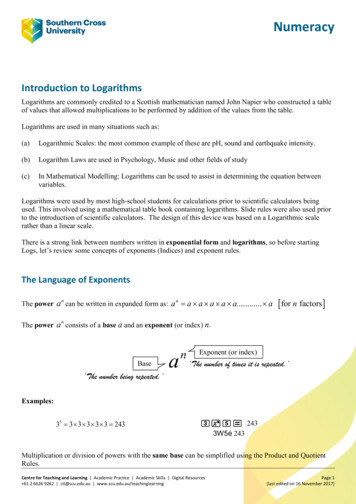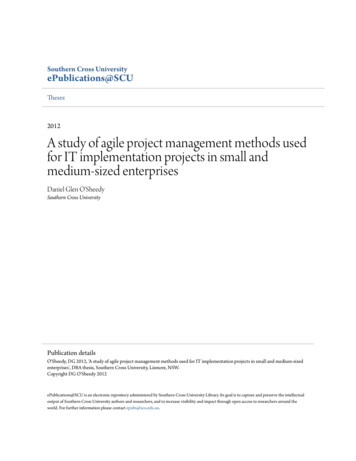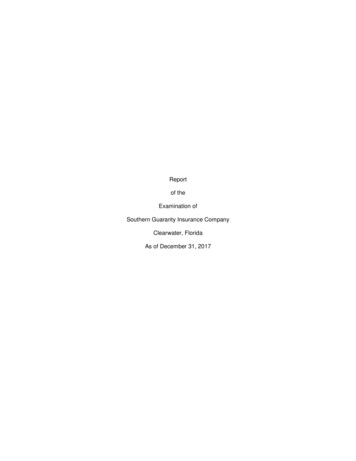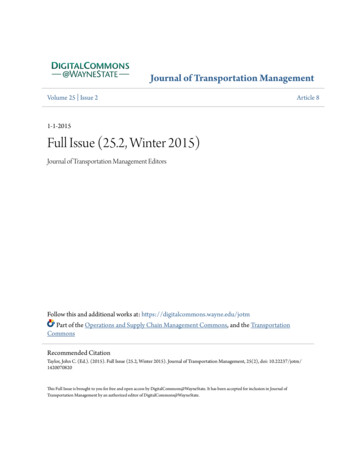
Transcription
NumeracyIntroduction to LogarithmsLogarithms are commonly credited to a Scottish mathematician named John Napier who constructed a tableof values that allowed multiplications to be performed by addition of the values from the table.Logarithms are used in many situations such as:(a)Logarithmic Scales: the most common example of these are pH, sound and earthquake intensity.(b)Logarithm Laws are used in Psychology, Music and other fields of study(c)In Mathematical Modelling: Logarithms can be used to assist in determining the equation betweenvariables.Logarithms were used by most high-school students for calculations prior to scientific calculators beingused. This involved using a mathematical table book containing logarithms. Slide rules were also used priorto the introduction of scientific calculators. The design of this device was based on a Logarithmic scalerather than a linear scale.There is a strong link between numbers written in exponential form and logarithms, so before startingLogs, let’s review some concepts of exponents (Indices) and exponent rules.The Language of ExponentsnThe power a can be written in expanded form as: a a a a a a. an[for n factors]nThe power a consists of a base a and an exponent (or index) n.Base‘The number being repeated.’anExponent (or index)‘The number of times it is repeated.’Examples:35 3 3 3 3 3 2433 5 2433W5é 243Multiplication or division of powers with the same base can be simplified using the Product and QuotientRules.Centre for Teaching and Learning Academic Practice Academic Skills Digital Resources 61 2 6626 9262 ctl@scu.edu.au www.scu.edu.au/teachinglearningPage 1[last edited on 16 November 2017]
The Product Rule32 34 36 729am an a m nWhen multiplying two powers with the samebase, add the exponents.4 1 45 42 4 1 5 2 46 4096b 2 b 7 b 2 7 b9The Quotient Rulemn37 32 37 2 35 243m na a aWhen dividing two powers with the samebase, subtract the exponents.42 44 43 42 4 3 43 64e6 e 4 e6 4 e 2The zero exponent rules can also be used to simplify exponents.The Zero Exponent Rule30 11137500 1e0 10( 4x) 10a 1A power with a zero exponent is equal to 1.The power rule can help simplify when there is a power to a power.The Power Rule(a )m n aTwo more useful Power Rules are:(ab) m a mb m or a mb m (ab) mmmaa a a m or m bb b b 2 40 6When a power is raised to a power, multiplythe exponents.m( 3 ) 3 3 6561( 5 ) 5 5 1(b ) b b2 4m nm0 62 72 7( 3a ) 3( 5a )2 3801433 a 3 53 a 2 3 125a 644256 4 4 4a a aThe negative exponent rule is useful when a power with a negative exponent needs to be expressed with apositive exponent.Page 2
The Negative Exponent Rulea11mor aama m m1 32114 411b 7 7b23 Take the reciprocal and change the sign of theexponent.19144 4 a 3 4a 3 3aThe fraction exponent rule establishes the link between fractional exponents and roots.The Fractional Exponent Rule1nna amor233( a)n 33p4 m 3 82 4 8for unit fractions, orn23 a amn1214b for any fraction4p31 1b41b4Exponent Functions found on a Scientific CalculatorFunctionAppearance of Key ExampleSquare 32d3d 9Cube 23D2D 8Any exponent 35for W16Square roots or s3 5 2433W5é 243s16 4qD343 7Cube root3343S or SGenerally qDgives S or S(although this varies between differentmakes and models)Page 3
10qf200 1.69910q W 200p 1.699Any root10200F orxGenerally qfgives F orqW gives x(although this varies between differentmakes and models)Page 4
NumeracyDefinition of a Logarithm“When you think about Logarithms you should think aboutexponents (indices)”The number 32 can be written as 25.Q: Does that mean that the Logarithm of 32 is equal to 5?A: Partially! The logarithm of 32 does equal 5 but only when a base of 2 is used.As a Logarithm, this can be written as log 2 32 5We know that 216 63the Log (logarithm) of 216 to the base 6 is 3The log is the exponent (3); the exponent is 3 because the base used was 6.216 63 is equivalent to writing log 6 216 3216 63 is written in exponential formlog 6 216 3 is written in logarithmic formCentre for Teaching and Learning Academic Practice Academic Skills Digital Resources 61 2 6626 9262 ctl@scu.edu.au www.scu.edu.au/teachinglearningPage 1[last edited on 16 November 2017]
A few more examples:625 54 is equivalent to writing log 5 625 41 000 000 106 is equivalent to writing log10 1 000 000 61024 210 is equivalent to writing log 2 1024 10Integral and fractional exponents are also possible11 12 3 is equivalent to writing log 2 3 (alternatively log 2 0.125 3 ) 38 285 1225 25 250.5 is equivalent to writing log 25 5 0.51 70 is equivalent to writing log 7 1 0Generalising all of the above:If a number (N) is written as a power with a base (b) andan exponent (e), such asN bethen log b N e .The base, b, must be a positive number (b 0) and notequal to 1 (b 1).The number, N, must also be positive (N 0)Examples:Write the following in logarithmic form.(a)Exponential Form36 62Logarithmic Formlog 6 36 2(b)128 27log 2 128 7(c)1 90log 9 1 0(d)(e)(f)113 9 2 ( 9 is the same as 9 2 )24 83a c2122log8 4 3log 9 3 log c a 2Page 2
The base is 6The base is 6216 63 is equivalent to writing log 6 216 3The exponent is 3The log of the number is 3Note: The logarithm of 1 to any base is always 0.log b 1 0Why? Remember the zero exponent ruleb 0 1 written as 1 b 0 In Logarithmic Form becomeslog b 1 0Video ‘The Definition of a Log(arithm) 1’In the next set of questions, the logarithmic form is given and is to be written in exponential form.Write the following in exponential form.Logarithmic FormExponential Form(a)log 5 25 225 52(b)log10 1000 31000 103(c)log 5 a 3.5a 53.5(d)log b 10 210 b 2(e)log 2 9 k9 2kVideo ‘The Definition of a Log(arithm) 2’Page 3
Finding Log ValuesYour scientific calculator can find the values of logs. Most scientific calculators have two logarithmicfunctions; Ordinary Logarithms and Natural Logarithms.Ordinary Logarithms have a base of 10. Because we use a base 10 number system, it seems straightforward that Logs with a base of 10 are used. The Log key on a scientific calculator has the appearance g.‘When you are calculating the log of a number, you can assume it is with a base of ten unless it is indicatedotherwise.’In ordinary logarithms, when you find the Log of a number, you are finding the exponent when a base of 10is used.Find the value of Log 25 (meaning Log10 25)On your calculator, the sequence of keys is: g25 1.397940009If Log 25 1.397940009 this can be written in exponential form as 25 101.397940009 .Find the value of Log14500 (meaning Log1014500)On your calculator, the sequence of keys is: g14500 4.161368002If Log14500 4.161368002 this can be written in exponential form as 14500 104.161368002 .Page 4
Natural LogarithmsNatural Logarithms have a base of e. You may already know about π (pi) which is a constant used insituations involving circles or cyclic events. The constant e is used in situations involving growth and decaysuch as population growth.The constant e has a value 2.7183 (rounded to 4 decimal places).The natural log key on a scientific calculator has the appearance h.The natural log of a number can be written as ln N or log e N . When you find the natural log of a number,you are finding the exponent when a base of e (2.7183) is used.Find the value of ln 25 (which is equivalent to log e 25)On your calculator, the sequence of keys is:h25 3.218875825The ln 25 3.218875825 which in exponential form is 25 e3.218875825 .Find the value of ln14500 [or log e14500]On your calculator, the sequence of keys is:h14500 9.581903928The ln14500 9.581903928 which in exponential form is 14500 e9.581903928 .Video ‘Logs - Using your calculator’It would be unusual to be asked to find a logarithm of a number with a base different to 10 or e. If you were,then the section below is relevant.Page 5
Other BasesFinding the value of a logarithm to a base other than 10 or e can be performed on you calculator.However, this requires the use of one of Log Laws. The Log Laws are covered in another section. The LogLaw used here is called the Change of Base Law.This law allows a logarithm with a given base to be changed to a new base, the new base being one that isavailable on your calculator, that is, base 10 or base e.The Change of Base Law can be stated as:Log a N Logb NLogb aIf base 10 is chosen as the new base, then the Law can be written as:Log10 N LogN Log a N Log10 aLogaIf base e is chosen as the new base, then the Law can be written as:Log e N ln NLog aNLog e a ln aFor example: Find the value oflog 4 40Using the Change of Base Law:Using the g key.log 40 1.602059991 2.661 (to 4 d.p.)log 4 0.602059991Calculator key sequence: g40Pg4 2.660964047log 4 40Using the h key.log e 40 ln 40 1.602059991 2.661 (to 4 d.p.)log e 4ln 4 0.602059991Calculator key sequence: h40Ph4 2.660964047log 4 40Page 6
Working in reverse!If you are presented with a question where you know the ordinary logarithm of the number and you want tofind out what the number is, then you will be working in reverse.Such a question will be present like this one:log x 0.4771Remember, if no base is given then the implied base is 10. Writing in the base in the question will assist ingetting to a solution.The question can be rewritten as:log10 x 0.4771Now, using the definition of a logarithm, x 100.4771Look closely at your calculator, you will notice that the SHIFT (or 2nd F) of the log key is G or (10 x ) . Thelog and its inverse use the same key!Using the calculator, for example, qg0.4771 The answer 2.999853181 will be displayed. Remember qg gives the G or (10 x ) function. For all practicalpurposes the value of x is 3.log 0.4771 x 310 xIf the question involves natural logs, a question could be written as:ln x 2.14Remember, ln implies natural logs, so the implied base is e, writing in the base in the question will assist ingetting to a solution.The question can be rewritten as:log e x 2.14Now, using the definition of a logarithm, x e 2.14Look closely at your calculator, you will notice that the SHIFT (or 2nd F) of the ln key is H or (e x ) . The lnand its inverse use the same key!Using the calculator, for example, qh2.14 The answer 8.499437629 will be displayed. Remember qh gives the H or (e x ) function. For all practicalpurposes the value of x is 8.5 !log e x 2.14 x 8.5If the question involves a logarithm of any base, a question could be written as: log 5 x 0.6065 This wouldbe unlikely to occur but if it did it is quite easily solved.Page 7
Now, using the definition of a logarithm, x 50.6065This time you will use a familiar key; the f or w.Using the calculator, for example, 5f0.6065 The answer 2.654149047 will be displayed. For practical purposes the value of x is 2.65 depending on theaccuracy required.log 0.60655 x x 2.65Video ‘Logs in reverse!’Page 8
Activity1. Write the following in logarithmic form.(a)25 52(b)1024 45(c)11.18 51.5(d)908.14 36.2(e)0.015625 8 2(f)490.5 7(g)0.4884 6 0.4(h)0.5 4 0.5(i)7.389 e 2(j)1.568 e0.452. Write the following in exponential form.(a)log100 2(b)log 2 1024 10(c)log 2.65 0.4232(d)log 4 100 3.322(e)ln1 0(f)ln 20 2.996(h)ln 5 1.6094(g)log100 10 123. Evaluate the following logarithms using your calculator. Answer to 4 decimal places.(a)log 250(b)log 2.95(c)log 0.1(d) 3 log 8 (e)ln 3.05(f)ln1000(g)ln 0.025(h) 1 ln 9 (i)log 4 32(j)log 0.25 44. Working in reverse, find the value of x.(a)log x 0.7782(b)log x 2.8779(c)log x 0.9031(d)log ( 2 x 1) 1.6902(e)ln x 2.72(f)ln x 0.75(g)ln x 0.5(h)(i)log 2 x 2.72(j)34log 5 x 0.25ln 2 x Page 9
NumeracyIntroductionBefore starting this topic you should review the Definition of a Log topic.Properties of LogarithmsThese are the basics of Logs, based on the definition of Logs.log a 1 0 ln1 0, log1 0log a a 12. ln e 1, log10 11.3.log a a n n ln e n , log10 n4.nnFrom exponents, we know that any number raised to the power of 0 isequal to 1, ie: a 0 1 , using the definition of a Log, log a 1 0From exponents, we know that any number raised to the power 1 is itself,ie:a1 a , using the definition of a Log,log a a 1From exponents, a n a n , using the definition of a Log, log a a n na loga n n eln x x , 10log x xStarting with log a n log a n , using the definition of a Log, inexponential form: n a loga nThe Three Logarithm LawsThe Log Laws help simply Log expressions.The first law: (Product Rule)log b A log b B log b ABNote: all three bases are the same.Proof:Let log b A x then A b xLet log b B y then B b ythen AB b x b y b x y (Index Law 1)In exponent form: AB b x yto Log form: log b AB x y (using the definition)log log b A log b Bb ABExamples:Simplify log 2 5 log 2 4Centre for Teaching and Learning Academic Practice Academic Skills Digital Resources 61 2 6626 9262 ctl@scu.edu.au www.scu.edu.au/teachinglearningPage 1[last edited on 7 September 2017]
log 2 5 log 2 4 log 2 ( 5 4 ) log 2 20Simplify log 5 log 8 log 3 (with no base mentioned, the inference is that the base is 10)log 5 log 8 log 3 log ( 5 8 3) log120Simplify log 2 x log 3 ylog 2 x log 3 y log ( 2 x 3 y ) log 6 xySimplify ln x ln y ln10(Remember: the natural logarithm is base e)ln x ln y ln10 ln( x y 10) ln(10 xy )The first law used in reverse is: log 3 0.4771 and log 5 0.6990 , evaluate log 30Given log 2 0.3010,log 30 log ( 2 15 ) log ( 2 3 5 ) log 2 log 3 log 5 0.3010 0.4771 0.6990 1.4771The second law: (Quotient Rule)Alog b A log b B log bBNote: all three bases are the same.Proof:Let log b A x then A b xLet log b B y then B b yA bxb x y (Index Law 2)then B byA bx yBAto Log form: log b x y (using the definition)BA loglog b A log b BbBIn exponent form:Page 2
Examples:Simplify log 2 20 log 2 4log 2 20 log 2 4 20 log 2 4 log 2 5Simply log 50 log 5 log 2log 50 log 5 log 2 log 50 (log 5 log 2) log 50 log1050 log10 log 5Or in reverse:Given log 2 0.3010, , evaluate log 50log 50100 log2 log100 log 2 2 log 2 (log10 100 2 because 100 102 ) 2 0.3010 1.699The third law: (Power Rule)log a x n n log a xProof:let log a x mthen x a mx n ( a m ) raise both sides to the power of nnx n a mn using the power of a power exponent rulelog a x n mn (or nm) using the definition of a loglog a x n n log a xExamples: Evaluate (or simplify)log 31 1log 3 3 1log 3 3 1 3orlog 31 log 3 1 log 3 3 0 1 13log x 4 4 log xPage 3
3log log 3log 310 100010 1010 101log 10 log(10) 2 111log10 1 222The Change of Base Lawlog a N log b Nlog b aThis Law is useful for change a logarithm in any base to a logarithm with a base such as 10 or e so that a calculator may be used.Proof:Let m log a NUsing the definition of a Log: N a mN amlog b N log b a m take Log (base b) of both sideslog b N m log b a using third lawlog b N m rearranginglog b alog b N log a Nlog b aExampleEvaluate log 3 7log 7 ln 7 or alternatively log 3 ln 3 Using a calculator gives 1.7712 (to 4 d.p.)log 3 7 Evaluate log 2 5 log 3 7log 2 5 log 3 7log 5 log 7 log 2 log 3 4.0932 ( to 4 d.p.)Video ‘Using Logarithm Laws’Page 4
Mixed examples:Evaluate log 2164164 log 2 2 6log 2 164 log 2 1 log 2 6411 2 6664 2log 2 6 log 2 2 0 log 2 26or 0 6 log 2 2 6 0 6 6Evaluate 3log 3 25 2 log 3 53log 3 25 2 log 3 5 log 3 253 log 3 522535256 log 3 25 log 3 54 log 3 253 5 )( 2 356 log 3 625Evaluate2 log 7 1253log 7 52 log 7 1253log 7 5 2 log 7 533log 7 5 6 log 7 53 log 7 5 2Page 5
Evaluate log 2 3 log 3 4 log 4 5 log 5 8log 2 3 log 3 4 log 4 5 log 5 8 log 3log 2 log 8log 2 log 23log 2 3 log 2log 4log 3 log 5 log 8 log 4 log 5log 2 3Write as a single logarithm log x 3log y 4 log zlog x 3log y 4 log z log x log y 3 log z 4 logxy 3z4x2 yWrite in terms of individual logs: lne2x ylne ln x 2 ln y ln e1 2 ln x ln y 2 1 ln e log e e 11 2 ln x ln y 12Simplify 2 4 log 3 x2 4 log 3 x Express 2 as a Log with base 3log 3 9 log 3 x 4 2 log 3 3 log 3 32 log 3 9 2 log 3 9 x 4Page 6
Activity1.Evaluate the following without a calculator(a)log 2 32(b)log 5 125(c)log 2116(d)log10 0.001(e)log 5 5(f)(g)log n 4 n(h)2.log22log x x 3Evaluate the following:(a)log 3 5 log 3 1.8(b)log 5 10 log 5 50 log 5 0.25(c)log 2 3 log 2 24 log 2 9(d)log 7 8 log 7 6 log 7 4 log 7 3(e)log 2 5 log 2 10(f)2 log 2 3 log 2 36(g)5log 3 8 2 log 3 16(h)3log10 5 log10 2(j)log 3 36log 3 6(i)(k)(m)3.11log 2 27 log 2 36322 log 5 83log 5 4log 2 3 log 3 4log 7 x(l)(n)log 7 x xlog 5 10 log100 5Write as a single Logarithm:(a)log x a log x b log x c(b)(c)2 log a x 2 log a y 2 log a z(d)1 2 log a b log a ab(e)log 3 abc log 3 b 2 log 3 b(f)2 log a ( x 3) log a ( x 2 9)(g)2 log a a 2(h)ln( x 5) 22 log b x log by log b 7 3log b zPage 7
4.(a)(c)(e)5.Write in terms of individual logs2log x ab clog 5(3x y2) 1 log a (b) x2 y log a z (d)log a xy 3(f) 8 log 2 2 ab Write in terms of individual logs(a)3log 2 x 1(b)3 2 log 3 x(c)log 5 x 2(d)2 log 2 x 3log 2 y 2Page 8
NumeracySolving Logarithms and Exponential EquationsLogarithmic EquationsThere are two major ideas required when solving Logarithmic Equations.The first is the Definition of a Logarithm. You may recall from an earlier topic:If a number (N) is written as a power with a base (b) andan exponent (e), such asN bethen log b N e .The base, b, must be a positive number (b 0) and notequal to 1 (b 1).The number, N, must also be positive (N 0)For the equation below, changing the Logarithm form to Exponential form will solve for the variable x.(These were covered in the Definition of a Log topic)log10 x 2x 102x 100Note:When solving any Logarithm equations, you shouldperform a check to see that the answer(s) obtained wereconsistent with the definition of a Log.Similar to this, the question below is solved using the definition of a Log and knowledge of equationscontaining exponents.log x 25 225 x 2x 5Centre for Teaching and Learning Academic Practice Academic Skills Digital Resources 61 2 6626 9262 ctl@scu.edu.au www.scu.edu.au/teachinglearningPage 1[last edited on 7 September 2017]
Check:As the base of a Log must be (b 0) and (b 1), thesolution x -5 is not consistent with the definition.The solution to this question is x 5This type of question can become more complex depending on the numbers. In this example, a calculator isrequired. You may need to review Exponents – Equations with Exponents.log x 22 2.122 x 2.1x 2.1 22x 4.358 to 3 d.p.A third type is where the variable becomes the exponent. For example:log 4 5 x can be rewritten using the definition of a log to be 5 4 x which can be solved as an exponentialequation (see below). However, a much easier method of solution is to use the Change of Base Rule.log 4 5 xlog 5 ln 5 alternatively log 4 ln 4 x 1.161 to 3 d.p.x The second major idea is based on equivalence. Put simply:If .log b M log b Nthen M NNote: There must be a single Log term on each side ofthe equals sign.Example:Example:log x log 5 log 20log 5 x log 205 x 20x 4 Using Log Rule 1 (Product Rule)2 ln x ln 36ln x 2 ln 36 Using Rule 3 (Power Rule)x 2 36x 6Page 2
Check: The logarithm can only be found of positive values only,so the solution is x 6.Some equations will contain a mix of Log terms and numbers, there are two strategies to solve this;(i)Rearrange to get Log terms on one side and number(s) on the other,or(ii)Replace the number with an equivalent Log. For example - 1 is the same as log 4 4 ,log 5 5 , log1010 etc.Example: Solve for x: log 4 (2 x 4) 2 log 4 3Using strategy (i)Using strategy (ii)log 4 (2 x 4) 2 log 4 3log 4 (2 x 4) 2 log 4 3log 4 (2 x 4) log 4 3 2log 4 (2 x 4) 2 log 4 4 log 4 3 2x 4 log 4 2 3 2x 4 2 43 2x 4 1632x 4 48log 4 (2 x 4) log 4 42 log 4 3 2x 4 log 4 log 4 3 16 2x 4 3162x 4 482 x 44or2 x 44x 22x 22Mixed examples:(i) Solve for x. log 9 x 0.5log 9 x 0.5x 90.5x 9x 3log y 2 log x log 8(ii) Express y in terms of x: log y 2 log x log 8 y log x 2 log 8loglog y log 8 x 2y 8x2(iii) Express y in terms of x: 2 ln y 3 4 ln xPage 3
2 ln y 3 4 ln xln y 2 ln x 4 3lny2 3x4y2 e34xy 2 e3 x 4y e3 x 4(iv) Solve for x: log 6 x log 6 ( x 5) 2log 6 x log 6 ( x 5) 2log 6 ( x 2 5 x) 2x2 5x 36x 2 5 x 36 0( x 4)( x 9) 0 x 4 or 9Check: Because it is not possible to have the Log of a negativenumber, the solution is x 4.Video ‘Solving Logarithmic Equations’Page 4
Activity1.Solve the following Logarithmic Equations.(a)log10 x 2(b)log 5 x 2(c)log 4 x 0.5(d)log 7 2 x 2(e)(g)(i)log 2 ( x 4 ) 3log 3 x 2 2log 2 ( x 2 x ) 32(h) x log 9 0.5 4 log 3 x 2(j)log x 4 4(f)(k)log x 9 0.5(l)log x 64 2(m)log x (2 x 1) 2(n)log x 3 2(o)log x 10 3(p)log 4 64 x(r)10log x 4Solve for x in the Logarithmic Equations.eln( x 4) 7(q)2.(a)2 log x log 4(b)2 ln 2 x ln 36(c)log( x 5) log x log 6(d)3log x log 4(e)2 log x log 2 x log 3(f)2 log 3 2 log 3 ( x 1) log 3 5(g)log 4 x log 4 6 log 4 12(h)3log 3 2 log 3 ( x 2) log 3 5(i)log8 ( x 2) 2 log8 2(j)log 2 x 5 log 2 ( x 4)(k)log x log 3 log 5(l)log x log( x 1) log 4(m)log( x 3) 3(n)(o)log 4 (2 x 4) 3 log 4 3(p)ln(4 x) ln 2 2 ln x2log 2 x 3log 2 2 log 2x3. Solve for y in terms of the other variables present.(a) y log x log 4log(b)(c) logy log 4 log x(d)11log 5 log x22log y log x log 4 2(e)log 5 x log 5 y log 5 3 1(f)2 ln y ln e 2 3ln x(g)log 2 y 2 log 2 x 5 log 2 4(h)log 7 y 2 log 7 5 log 7 x 2(i)3ln y 2 3ln x(j)(k)2 y ex(l) log y2(log 4 y 3log 4 x) 310 y 3x 1Page 5
Exponential EquationsAn equation where the exponent (index) is a variable or contains a variable is called an exponential equation.An example is 3x 20 .Let’s consider the example below:If an investor deposits 20 000 in an account that compounds at 5% p.a., how long is it before this amounthas increased to 30 000? (Compounded annually)Using the compound interest formula gives:A P(1 i ) n 30000 20000(1.05) nxor b x aThe first step is to rearrange the equation to get the form a b 30000 1.05n200001.5 1.05nThen take the log of both sides. Because calculations will need to be performed, ordinary logarithms ornatural logarithms should be used.1.5 1.05n1.5 1.05nlog1.5 log1.05n taking the log of both sideslog1.5 n log1.05 using the third log lawlog1.5 n rearranginglog1.05n 8.31ln1.5 ln1.05n taking the log of both sidesln1.5 n ln1.05 using the third log lawln1.5 n rearrangingln1.05n 8.31This means that it will take 8.31years (9 years in practice) for the growth in value to occur.This can be checked by calculating:1.058.31 1.5This example contains a simple power.3x 10log 3x log10x log 3 log10log10log 31x log 3x 2.096In this example, the 4 must be rearranged to obtain the power as the subject before taking the logarithm ofboth sides.x Page 6
4 7x 20207x 4x7 5log 7 x log 5x log 7 log 5log 5x log 7x 0.8271In this example, there is a power as the subject; however, the exponent is more complex than previousexamples.12.52 n 1 523.95log12.52 n 1 log 523.95(2n 1) log12.5 log 523.95log 523.952n 1 log12.52n 1 2.4792n 3.4790n 1.7395Example: Joan wants to retire when her superannuation fund reaches 500 000. She invests 1500 a month(after tax) into her superannuation fund. She assumes that the superannuation fund will return 6%pa or0.5%pm. How long before her goal is reached?This is a Future Value of an Annuity, with r 0.005, R 1500 and S 500000. (1 r )n 1 S R r (1 0.005 )n 1 500000 15000.005n2500 1500 (1 0.005 ) 1 mult both sides by 0.005 n1.6666 1.005 1 divide both sides by 15002.6666 1.005n add 1 to both sidesTo solve this exponential equation, logs are required.Page 7
2.6666 1.005nlog 2.6666 log1.005n take Log of both sideslog 2.6666 n log1.005 use Log Law 3log 2.6666 nlog1.005n 197 (rounded up)It will be 197 months or 16 years 5 months before Joan has enough money.Video ‘Solving Exponential Equations’Activity1.Solve the following exponential equations.(a) 4 x 20(c) 32 x 0.125(e) 6 x 1 4040(g) 2 x 12 x 411(i) 6 62.(b)(d)(f)(h)(j)1.6 x 3.24.60.5 x 10011.22 x 0.63 6 x 10 12.5x2 x 15 2If an investor deposits 250 000 in an account that compounds at 7% p.a., how long is it before thisamount has increased to 400 000? (Compounded semi-annually). Use the compound interest formula: A P(1 i ) nPage 8
NumeracyAnswers to activity questionsTopic: Definition of a Log1.Write the following in logarithmic form.(a)25 52log 5 25 2(b)1024 45log 4 1024 5(c)11.18 51.5log 5 11.18 1.5(d)908.14 36.2log 3 908.14 6.2(e)0.015625 8 2log8 0.015625 2(f)490.5 7(g)0.4884 6 0.4log 6 0.4884 0.4(h)0.5 4 0.5log 4 0.5 0.5(i)7.389 e 2log e 7.389 2 ( log e means ln)(j)1.568 e0.45ln1.568 0.45(b)log 2 1024 107 490.5log 49 7 0.5ln 7.389 22.Write the following in exponential form.(a)(c)log100 2log10 100 2100 102log 2.65 0.42321024 210(d)log 4 100 3.3222.65 100.4232(e)(g)ln 20 2.9960log100 10 10 1003.(f)ln1 01 e100 43.32220 e 2.99612(h)ln 5 1.60945 e1.609412Evaluate the following logarithms using your calculator. Answer to 4 decimal places.(a)log 250g250 2.3979log 2.95(b)g2.95 0.4698Centre for Teaching and Learning Academic Practice Academic Skills Digital Resources 61 2 6626 9262 ctl@scu.edu.au www.scu.edu.au/teachinglearningPage 1[last edited on 16 November 2017]
(c)log 0.1(d)g0.1 -1 3 log 8 g(3P8) -0.4260(e)(g)ln 3.05(f)ln 0.025h0.025 -3.6889(h)h3.05 1.1115ln1000h1000 6.9078 1 ln 9 h(1P9) -2.1972(i)(j)log 4 32log 32log 41.5051 0.6021 2.5 4.log 0.25 4 log 4log 0.25g4Pg0.25 -1Working in reverse, find the value of x.(a)log x 0.7782(b)0.7782(c)x 10x 6log x 0.9031x 102.8779x 754.9(d) 0.9031x 10x 0.125(e)ln x 2.72(f)(h) 0.5x ex 0.6065(i)log 2 x 2.72x 22.72x 6.589ln x 0.75x e0.75x 2.117x ex 15.18ln x 0.5log ( 2 x 1) 1.69022x 1 101.69022 x 1 49 add 1 to both sides2 x 50 divide both sides by 2x 252.72(g)log x 2.877934ln 2 x 0.75ln 2 x 2 x e0.752 x 2.117x 1.0585(j)log 5 x 0.25x 5 0.25x 0.6687Topic: The Logarithm Laws1.Evaluate the following without a calculatorPage 2
(a)(b)log 2 32log 5 125 log 5 53 log 2 25 3log 5 5 5log 2 2 3 5(c)1log 216 log 2 2 411 2 4416 2(d)log10 0.001 log10 10 3 3log10 10 3 4(e)(f)log 5 5 log 5 5log12( 2) 2 log ( 2 ) 2(h)log n n14(b)3x232log 5 10 log 5 50 log 5 0.25 log 5 (10 50 0.25) log 5 1252 log 3 9 log 2 log 3 333 2(d)log 2 3 log 2 24 log 2 9( 3 24 ) log 2 8 313 2x )( 3log x x23 2 log 3 5 1.8 log 2x3 2.Evaluate the following:(a) log 3 5 log 3 1.8(c)log x x 3 log x x1 log n n41 4 log 3 92224 log n n2 log1 log 5 521 2(g)29 3log 7 8 log 7 6 log 7 4 log 7 3 log 7( 8 3)( 6 4)2424 log 7 1 log 7 0Page 3
(e)(f)log 2 5 log 2 10510 log 232 log 2361 log 24 log 2 2 25 log 2 log 22 log 2 3 log 2 362 512 log 2 2 12 2125log 3 8 2 log 3 16 (g)(h)85 log 3 216215 log 3 82 log 3 27(i)3log10 5 log10 2532 log10 62.5 log10 7 log 3 211log 2 27 log 2 36321(j)log 3 36log 3 61 log 2 27 3 log 2 36 2log 3 62 log 3 6 log 2 3 log 2 636 log 2 2 1 log 2(k) 1 2 log 5 233log 5 22 6 log 5 26 log 5 2 1log 3 6 2(l)2 log 5 83log 5 42 log 3 6log 7 xlog 7 x x log 7 x123log 7 x 21log 7 x2 3log 7 x211 2 1 2 3 2 3 32Page 4
(m)log 2 3 log 3 4(n)log 3 log 4 log 2 log 3log 4 log 2 log 5 10 log100 5log 22log 22 log 2 log10 log 5 log 5 log100 12log 2 23.Write as a single Logarithm:(a)log x a log x b log x c log x(c)(b)abc2 log a x 2 log a y 2 log a z11(d) log 37 x2 y 2 log bz31 2 log a b log a ab log a a 2 log a b (log a a log a b) log a a 2 log a b log a a log a b 2 log a(e)y log b 7 3log b z log b x 2 log b y 2 log b 7 log b z 3 2(log a x log a y log a z )xyzlog 3 abc log 3 b 2 log 3 b2 log b x log b(f) log a b2 log a ( x 3) log a ( x 2 9) log a ( x 3) 2 log a ( x 2 9)a b2 cb2 log 3 ac log a( x 3) ( x 3)( x 3) ( x 3)( x 3)( x 3)ln( x 5) 2 ln( x 5) 2 ln e log a(g)2 log a a 2(h) 4 ln( x 5) ln e 2 ln e 2 ( x 5)4.Write in terms of individual logs(a)log x ab 2 c(b) log x a log x b 2 log x c x2 y log a z log x a 2 log x b log x c log x x 2 log x y log x z1 2 log x x log x y log x z21 2 log x y log x z2Page 5
(c)log 5(3x y2)(d)1 log 5 3 x log 5 y 2 (e) log a ( xy 3 ) 21log 5 x 2 log 5 y3 1 log a log1 log a log alog a xy 31 log a ( xy 3 )211log a ( x) log a ( y 3 ) 2213log a ( x) log a ( y ) 22(f) 8 log 2 2 ab log 2 8 log 2 (ab 2 ) log 2 23 (log 2 a log 2 b 2 ) 3log 2 2 log 2 a 2 log 2 b 3 log 2 a 2 log 2 bPage 6
5.Write in terms of individual logs(a)3log 2 x 1(b)3 2 log 3 x log(2 x) log10 3log 3 3 2 log 3 x8 x3104 x3 log5log 5 x 2 log 3 33 log 3 x 23 log(c) log 3(d)27x22 log 2 x 3log 2 y 5 log 5 x 2 log 5 5 log 2 x 2 log 2 y 3 log 2 25 log 2 ( 32 x 2 y 3 ) x log 5 25 Topic: Solving Logarithmic and Exponential Equations1.Solve the following Logarithmic Equations.(a)log10 x 2(b)log 5 x 2(d)x 5 21x 25log 7 2 x 2x 102x 100(c)log 4 x 0.5x 40
The zero exponent rules can also be used to simplify exponents. The Zero Exponent Rule a0 1 A power with a zero exponent is equal to 1. 310 113750 10 e0 1 (41x)0 The power rule can help simplify when there is a power to a power. The Power Rule (aam mn)n When a power is raised to a










